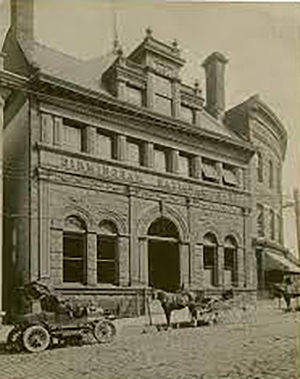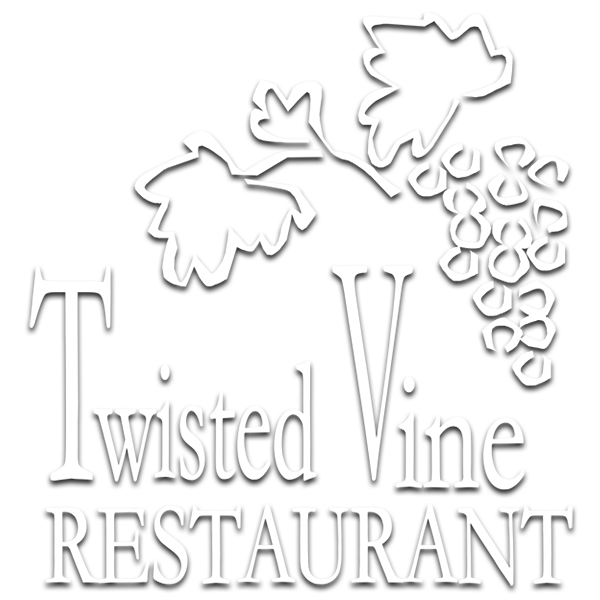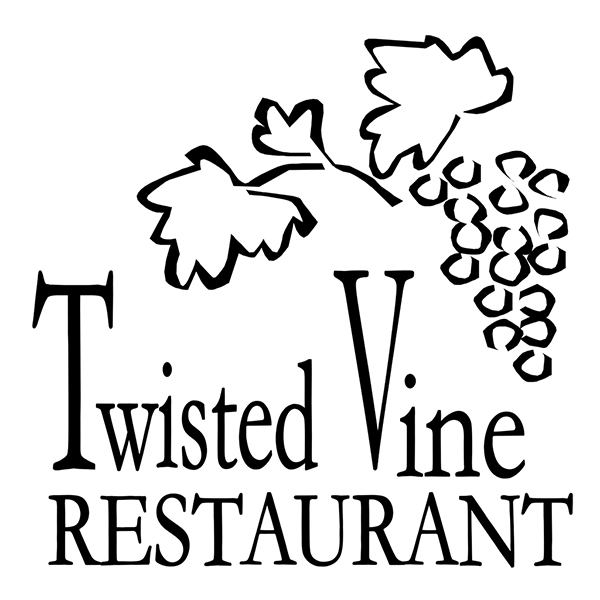About
 Image above found on internet
Image above found on internet
Twisted Vine Restaurant, located on Main Street in Derby, Connecticut is one of the top Italian Restaurants in the area. Open since July 2005 and formerly Tartaglia's and the Old Birmingham Restaurant, the comfortable yet elegant atmosphere, with its impressive open space, brick walls, balconies and Victorian style chandeliers - continue to embrace the patrons as they dine.
Noted as one of the “Most Haunted Restaurants in the United States”, this historic landmark, built in 1892 was originally the old Birmingham National Bank and still maintains the original vault from the bank in the main dining room. When you walk into the dining room you will be impressed with the original thick oak mouldings and stained-glass windows that once surrounded Valentino-crazed tellers and portly pinstriped bankers. It was turned into a restaurant in the late 1970's.
From Historic Buildings CT Website
"The old Birmingham National Bank building is on Main Street in the City of Derby, which was once known as Birmingham. The bank was originally chartered in 1848 as the Manufacturers Bank of Birmingham, with Edward N. Shelton as its first president, and in 1865 became a national bank. Constructed in 1892-1893, the building features an elaborately detailed facade with terra cotta molding in the Sullivanesque, Neo-Grec and Richardsonian Romanesque Revival styles. The building is now the Twisted Vine Restaurant."
Information provided by a customer who did research on the history of this building
The image on the top of the page is compile of first three pictures which were originally published in 1896, by the Transcript Company, Derby, Conn., illustrated and compiled by Charles Gillespie.
History on the Bank, which you will see was the Birmingham National Bank at that time. Note the name changes, the many well known local names and the description of the vault and the safe deposit facility.
BIRMINGHAM NATIONAL BANK
This bank was chartered and organized in 1848 under the name of the Manufacturers Bank of Birmingham. In 1865 it entered the national banking system and adopted the name the Birmingham National Bank, but no change was made in capital, assets of management. Its capital stock at first was $100,000, which was increased in 1853 to $300,000, it present capital. Active among the founders were Edward N. Shelton, John I. Howe, Fitch Smith, Sidney Downs, Thomas Burlock, William Guthrie, Lewis Downs, Hezekiah S. Nichols and Edward Lewis, who were elected as the first board of directors. Nearly all of these men were prominent in the manufacturing life of Derby at that time. The first officers were Edward N. Shelton, president, and James M. Lewis, cashier. In 1853 Mr. Lewis resigned to become cashier of a New York bank and was succeeded by Joseph Arnold of the Meriden Bank, who most ably filled the position of cashier until the time of his death in 1884. Charles E. Clark, who had been teller of the bank from 1866, was elected Mr. Arnold's successor, and still occupies the office. Mr. Shelton held the position of president continuously from his first election in 1848 until his decease in September, 1894, a worthy and most remarkable record. He was succeeded in office by Charles H. Nettleton, for many years a director of the bank and a prominent business man of the community.
This bank has always been well and successfully managed, not only paying regular dividends to its stockholders, but also accumulating a handsome surplus; at the same time it has by its liberal policy been a most useful and important factor in the building up of this community, to whose citizens it is justly a source of satisfaction and pride. The present building, erected in 1892-93 and occupied since that date, is one of the finest banking buildings in the state. With a handsome exterior and interior, convenient for both customer and employees, it was intended as nearly as possible to make it a model.
A prominent feature of the new building is its vault and superior safe deposit facility. The vault, with its heavy walls of chrome steel and massive doors controlled by improved automatic locks, is believed to be the strongest safe in this vicinity. Inside of this vault are placed a large number of deposits safes which are rented to patrons. These safes are absolutely in the control of the parties renting them, and make a secure place for the storage of bonds, notes and valuables of every kind. Adjoining the vault are small rooms for the special use of parties renting these safes, where papers can be examined, coupons cut off and valuables deposited or withdrawn without interruption.
Foreign exchange is bought and sold and letters of credit furnished available in all parts of the world. The statement of the bank's affairs Dec. 1, 1895, shows the following excellent condition: Capital, $3000,000; surplus and undivided profits, $218,500; deposits, $395,000. The bank ranks among the strong financial institutions of the state, and with ample capital and every facility for the proper handling of business fills the requirements of the community in a most complete and satisfactory manner.
The present board of directors consists of the following well known business men: Merritt Clark, William E. Downs, Charles H. Nettleton, Charles E. Clark, William C. Atwater, H. Frank Wanning, Daniel S. Brinsmade, H. Holton Wood, Watson J. Miller. The officers and employees are: Charles H. Nettleton, president; Charles E. Clark, vice-president and cashier; William S. Browne, bookkeeper: Sanuel H. Lessey. corresponding clerk: Herbert L. Whitney, teller: Robert L. Flynn, clerk: Edward W. Kneen, clerk: James Forbes, messenger.
Noted as one of the “Most Haunted Restaurants in the United States”, this historic landmark, built in 1892 was originally the old Birmingham National Bank and still maintains the original vault from the bank in the main dining room. When you walk into the dining room you will be impressed with the original thick oak mouldings and stained-glass windows that once surrounded Valentino-crazed tellers and portly pinstriped bankers. It was turned into a restaurant in the late 1970's.
From Historic Buildings CT Website
"The old Birmingham National Bank building is on Main Street in the City of Derby, which was once known as Birmingham. The bank was originally chartered in 1848 as the Manufacturers Bank of Birmingham, with Edward N. Shelton as its first president, and in 1865 became a national bank. Constructed in 1892-1893, the building features an elaborately detailed facade with terra cotta molding in the Sullivanesque, Neo-Grec and Richardsonian Romanesque Revival styles. The building is now the Twisted Vine Restaurant."
Information provided by a customer who did research on the history of this building
The image on the top of the page is compile of first three pictures which were originally published in 1896, by the Transcript Company, Derby, Conn., illustrated and compiled by Charles Gillespie.
History on the Bank, which you will see was the Birmingham National Bank at that time. Note the name changes, the many well known local names and the description of the vault and the safe deposit facility.
BIRMINGHAM NATIONAL BANK
This bank was chartered and organized in 1848 under the name of the Manufacturers Bank of Birmingham. In 1865 it entered the national banking system and adopted the name the Birmingham National Bank, but no change was made in capital, assets of management. Its capital stock at first was $100,000, which was increased in 1853 to $300,000, it present capital. Active among the founders were Edward N. Shelton, John I. Howe, Fitch Smith, Sidney Downs, Thomas Burlock, William Guthrie, Lewis Downs, Hezekiah S. Nichols and Edward Lewis, who were elected as the first board of directors. Nearly all of these men were prominent in the manufacturing life of Derby at that time. The first officers were Edward N. Shelton, president, and James M. Lewis, cashier. In 1853 Mr. Lewis resigned to become cashier of a New York bank and was succeeded by Joseph Arnold of the Meriden Bank, who most ably filled the position of cashier until the time of his death in 1884. Charles E. Clark, who had been teller of the bank from 1866, was elected Mr. Arnold's successor, and still occupies the office. Mr. Shelton held the position of president continuously from his first election in 1848 until his decease in September, 1894, a worthy and most remarkable record. He was succeeded in office by Charles H. Nettleton, for many years a director of the bank and a prominent business man of the community.
This bank has always been well and successfully managed, not only paying regular dividends to its stockholders, but also accumulating a handsome surplus; at the same time it has by its liberal policy been a most useful and important factor in the building up of this community, to whose citizens it is justly a source of satisfaction and pride. The present building, erected in 1892-93 and occupied since that date, is one of the finest banking buildings in the state. With a handsome exterior and interior, convenient for both customer and employees, it was intended as nearly as possible to make it a model.
A prominent feature of the new building is its vault and superior safe deposit facility. The vault, with its heavy walls of chrome steel and massive doors controlled by improved automatic locks, is believed to be the strongest safe in this vicinity. Inside of this vault are placed a large number of deposits safes which are rented to patrons. These safes are absolutely in the control of the parties renting them, and make a secure place for the storage of bonds, notes and valuables of every kind. Adjoining the vault are small rooms for the special use of parties renting these safes, where papers can be examined, coupons cut off and valuables deposited or withdrawn without interruption.
Foreign exchange is bought and sold and letters of credit furnished available in all parts of the world. The statement of the bank's affairs Dec. 1, 1895, shows the following excellent condition: Capital, $3000,000; surplus and undivided profits, $218,500; deposits, $395,000. The bank ranks among the strong financial institutions of the state, and with ample capital and every facility for the proper handling of business fills the requirements of the community in a most complete and satisfactory manner.
The present board of directors consists of the following well known business men: Merritt Clark, William E. Downs, Charles H. Nettleton, Charles E. Clark, William C. Atwater, H. Frank Wanning, Daniel S. Brinsmade, H. Holton Wood, Watson J. Miller. The officers and employees are: Charles H. Nettleton, president; Charles E. Clark, vice-president and cashier; William S. Browne, bookkeeper: Sanuel H. Lessey. corresponding clerk: Herbert L. Whitney, teller: Robert L. Flynn, clerk: Edward W. Kneen, clerk: James Forbes, messenger.


